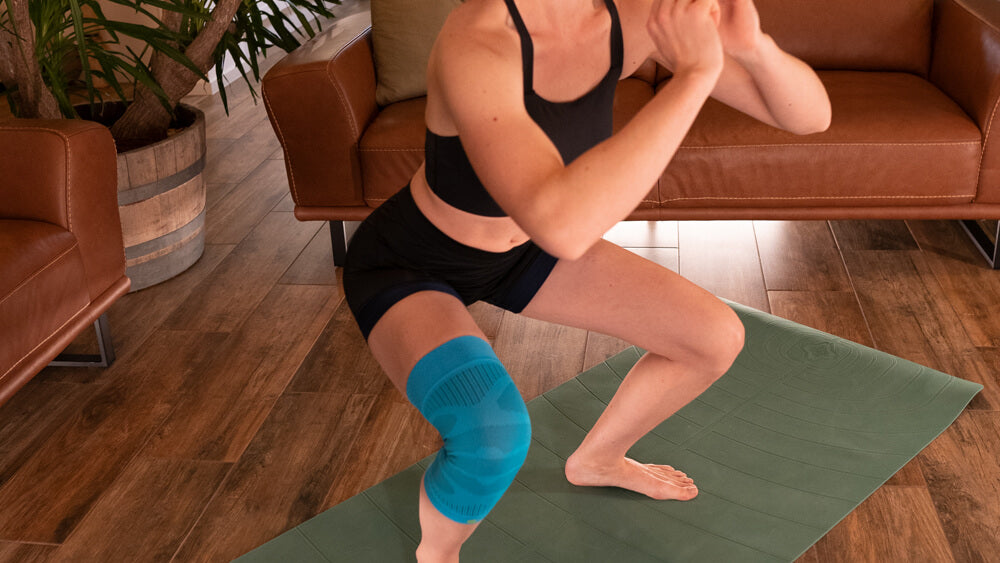Struggling to increase your running distance? Unfortunately, there is no quick and easy solution here. However, there are some steps you can take to help you succeed. From consistency to carbs to compression, here’s how to improve your running stamina.
Train consistently
Regular training is essential if you want to improve. It will help you increase your aerobic capacity (essentially, the amount of oxygen your muscles can use during exercise) and improve the strength of your running muscles. That said, a 30-minute jog once a week won’t be enough. You’ll need to go on 3-4 30-minute jogs a week and gradually increase your distance and time.
Gradually increase your running distance
Slowly build on your running distance every week. For example, if you ran 5 km three times last week, this week you can try for 5.5. Do note, though; you need to keep the increases at a minimum. Most experts recommend increasing your distance by 10% a week at maximum. Taking on too much too fast raises your risk of burnout and injury.
Do the right type of strength training
The stronger your muscles are, the longer they’ll last on your runs. But for the best results, you’ll need to take a measured approach.
- Aim for 2-3 15-minute strength-building workouts per week. You’ll start building some leg muscle without exhausting the muscle there
- Gradually increase your rep counts, the number of sets you do, or your resistance level. Keep in mind, though, that you shouldn't add all these at once.
- According to research study results, isometric and plyometric exercises are great for increasing stamina and boosting performance.
Isometric strength training

Isometric exercises are the most efficient at working your motor units, which are basically the foundation of all bodily movements, including voluntary (walking, running, lifting) and involuntary (breathing, blinking) ones. The exercises work by holding your muscles in a tensed isometric contraction rather than moving them in and out of that contraction. Some good isometrics to try include:
- Isometric squat. While holding a weight, go into your usual squat and hold it for a few seconds at the lowest point. Repeat 10 times. Try this with other squat variants to activate different muscle groups.
- Plank. Hold a plank for as long as you can. Make sure to keep your spine neutral. To properly activate your core, do not arch or curve too far. Yes, core muscles are important to running. They help maintain your chest cavity, allowing you to breathe easier. They also give your legs a base to push against and propel you forward. Not to mention, a strong core is crucial to good running posture and efficiently coordinating movements between your arms and legs.
- Isometric lunge. Go into a lunge and hold it for 5 seconds at the lowest point. Repeat 10 times per leg.
Plyometric strength training
Plyometrics are usually used for more explosive exercises like sprints. But they can also improve running stamina and endurance, reducing energy consumption while increasing power. Good plyometric exercises to try include:
- Burpees. These work almost every muscle group in the body and are great for improving muscle control and building leg strength. Though the trade-off is that many people find them extremely unpleasant to do.
- Bounding. This exercise is like an exaggerated run and is great practice for improving running efficiency. With each step, you’ll be pushing off hard to leap our ‘bound’ forward as fast and as far as you can.
- Jump squats. Go into a regular squat and jump up as high as possible. Jump squats will work your glutes, hamstrings, quads, and even your calves - all essential running muscles.
Work on your form to improve running stamina
Good running form can save your body a bit of stabilisation and movement work with every step and ultimately improve your performance.
- Eyes front
- Keep your spine neutral. You shouldn't slouch or arch your back when you run.
- Don’t swing your arms too much, and keep them close to your torso, with your elbows bent at 90 degrees. Holding your arms up too high leads to more energy expenditure.
- Aim for economic strides and mid-heel strikes rather than long, loping ones that have your foot hitting the pavement heel-first
- Don’t tense your arms and upper back. Any muscle you’re not using in your run should be nice and relaxed to conserve energy
- Don’t bounce. The more energy your body exerts on up and down movement, the less it has for forward movement. To reduce bounce, take low, short, and quick strides. Experts generally recommend a cadence (that is, how many times your foot hits the pavement) of 90 for maximum efficiency.
As a bonus, a good running form will also lower your risk of injury. For example, too much jolting or shock from bouncing increases your chances of developing shin splints.
Use compression

Sports Compression Calf Sleeves
Add Sports Compression Socks or Calf Sleeves to the mix. In no particular order, these will:
- Boost blood flow. Better circulation means your muscles get the oxygen and nutrients they need (and remove the waste they don’t) quicker, reducing the rate of fatigue
- Reduce muscle oscillation. Oscillations are the uncomfortable vibrations shooting up your legs when your feet hit the ground. Along with being uncomfortable, muscle oscillation can make you tire out faster and damage muscle tissues.
- Improve proprioception. Proprioception is how well your muscles activate and how accurately your brain registers the positioning of your body. Quality compression products communicate with your nerves to activate your muscles more efficiently when you run.
Not to mention, they’ll also help prevent injuries that can disrupt your stamina training routine. Socks and calf sleeves will reduce your risk of shin splints, while socks (as they support the foot) will help you avoid sprains.
Fuel your jogs right
Nutrition plays a huge role in your energy levels, power, and stamina. Firstly (and most obviously), your energy output should be around the same as your energy input. The specific amount of calories runners need varies by gender, muscle mass, weight, age, and even environment.
But generally, you’ll need 38-42 calories per kilogram of body weight for an hour-long run. So if you weigh 80 kilos, you’ll need to eat around 3,000 calories the day of your run. Not eating enough creates a calorie deficit, which your body will respond to by becoming weaker and slower.
Secondly, you’ll need a good mix of fats, carbs, and proteins to improve your running stamina.
- Carbohydrates are your key source of energy as they restore your muscle glycogen levels (muscle glycogen being your body’s energy reserve). If your muscles don’t have enough glycogen to draw on, they’ll fatigue significantly faster.
- Fats are also essential players in your energy levels. In fact, some studies suggest they’re your body’s go-to energy source (accounting for two-thirds of your energy output) if you’re doing moderate-intensity exercise like jogging.
- Proteins help you build muscle strength.
Thirdly, eat right. Make sure you get plenty of vitamin B, vitamin D, and iron, as these affect how your body metabolises energy, builds muscle strength, and transports oxygen and nutrients into the muscle, respectively.
To sum up
It takes time and work to improve stamina. But if you train consistently and progress at regular intervals, you’ll start seeing some improvement. And, of course, adding the right gear, foods, and strength training regimen into the mix will take you even further.
Explore more running supports: Running Supports and Compression
If you require assistance selecting the right product for your needs or wearing the brace, call us on 098015660 or contact us via live chat.
Do you have private health? Most private health extras will cover Bauerfeind Products. Check to see if yours is included. Bauerfeind Private Health Insurance Inquiry.
















